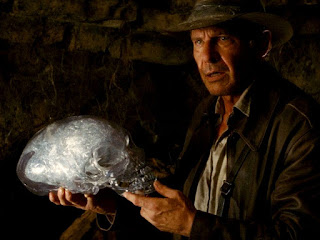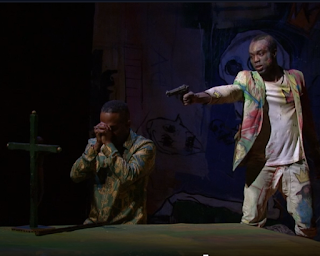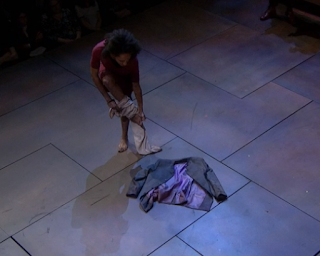Act V, scene i: That skull had a tongue in it and could sing once
Here we are in the final act of Hamlet, and one of the most iconic scenes of the play - the bit with the skull!
Two gravediggers are going about their business of digging a grave (that we immediately find out will be the final resting place of Ophelia) and making a few lighthearted observations as they do so. Though the graveyard setting foreshadows the tragedy that is about to beset Hamlet and the court, there is now a moment's pause in the chaotic hurtling towards a bitter end.
It's probably worth a few words on 'comic relief' in Shakespearean tragedy. The stage direction gives us 'Enter two clowns'. Although 'clowns' in Shakespeare's time would have referred to simple country folk (in this instance two manual workers doing their job, not connected with the court),something of the modern meaning is inherent in their comic purpose at this moment in the drama. Somehow they achieve comedic banter from the burial of the dead. It is typical of Shakespeare to use comedy in order to heighten more serious intent, and for the 'light relief' to have a more serious central argument pertinent to the themes of the play as a whole.
The audience are well aware that the Clown is talking about Ophelia from the giveaway pronoun in the opening question, 'Is she to be buried in Christian burial, when she wilfully seeks her own salvation?' (V.i.1-2).
The discussion of the rites of burial of someone who has committed suicide reverberate right back to Hamlet's opening soliloquy, that 'the Everlasting had not fix'd His canon 'gainst self slaughter' (I.ii.131-132). And debate remains over the nature of Ophelia's death, since she is indeed being given a Christian burial.
Here's a minute long clip showing the gravediggers' opening exchange from a company called 'Shakespeare At Play':
Hamlet and Horatio enter the scene - and of course, further dramatic irony is at play since they are not aware (yet) that this is Ophelia's grave. 'Has this fellow no feeling of his business a sings in grave-making?' Hamlet asks (V.i.65-66). 'Custom hath made it in him a property of easiness' as Horatio observes (V.i.67). Unsurprisingly, given their profession, the gravediggers are casual, matter-of-fact about death. It is often said that those who work in environments which regularly bring them into contact with death develop a bleak, 'black' humour as a protective coping mechanism.
The skulls that are unearthed and thrown onto the stage lead Hamlet towards further philosophical musing on the nature of life, death and human destiny. 'That skull had a tongue in it, and could sing once' (V.i.74). His preoccupation is with what happens to the human body after death - and his ideas return to the notion of death as the great leveller that were explored in the previous act. The recognition of Yorick's skull personalises Hamlet's abstract reflections on mortality.
Discussion now turns to action as the funeral procession enters. Gertrude makes a direct reference to her wish that Ophelia had been united in marriage with her son, 'I hop'd thou shouldst have been my Hamlet's wife' (V.i.237). Laertes 'leaps in the grave' for a final farewell to his sister, followed by a brief 'grapple' with Hamlet. Hamlet asserts his love for Ophelia, 'Forty thousand brothers/Could not with all their quantity of love/Make up my sum' (V.i.264-266). And Claudius reminds Laertes of their plan in the closing lines.
In addition to your own summary and notes,
 |
| Clue: Not Hamlet. |
Two gravediggers are going about their business of digging a grave (that we immediately find out will be the final resting place of Ophelia) and making a few lighthearted observations as they do so. Though the graveyard setting foreshadows the tragedy that is about to beset Hamlet and the court, there is now a moment's pause in the chaotic hurtling towards a bitter end.
It's probably worth a few words on 'comic relief' in Shakespearean tragedy. The stage direction gives us 'Enter two clowns'. Although 'clowns' in Shakespeare's time would have referred to simple country folk (in this instance two manual workers doing their job, not connected with the court),something of the modern meaning is inherent in their comic purpose at this moment in the drama. Somehow they achieve comedic banter from the burial of the dead. It is typical of Shakespeare to use comedy in order to heighten more serious intent, and for the 'light relief' to have a more serious central argument pertinent to the themes of the play as a whole.
The audience are well aware that the Clown is talking about Ophelia from the giveaway pronoun in the opening question, 'Is she to be buried in Christian burial, when she wilfully seeks her own salvation?' (V.i.1-2).
The discussion of the rites of burial of someone who has committed suicide reverberate right back to Hamlet's opening soliloquy, that 'the Everlasting had not fix'd His canon 'gainst self slaughter' (I.ii.131-132). And debate remains over the nature of Ophelia's death, since she is indeed being given a Christian burial.
Here's a minute long clip showing the gravediggers' opening exchange from a company called 'Shakespeare At Play':
Hamlet and Horatio enter the scene - and of course, further dramatic irony is at play since they are not aware (yet) that this is Ophelia's grave. 'Has this fellow no feeling of his business a sings in grave-making?' Hamlet asks (V.i.65-66). 'Custom hath made it in him a property of easiness' as Horatio observes (V.i.67). Unsurprisingly, given their profession, the gravediggers are casual, matter-of-fact about death. It is often said that those who work in environments which regularly bring them into contact with death develop a bleak, 'black' humour as a protective coping mechanism.
The skulls that are unearthed and thrown onto the stage lead Hamlet towards further philosophical musing on the nature of life, death and human destiny. 'That skull had a tongue in it, and could sing once' (V.i.74). His preoccupation is with what happens to the human body after death - and his ideas return to the notion of death as the great leveller that were explored in the previous act. The recognition of Yorick's skull personalises Hamlet's abstract reflections on mortality.
Discussion now turns to action as the funeral procession enters. Gertrude makes a direct reference to her wish that Ophelia had been united in marriage with her son, 'I hop'd thou shouldst have been my Hamlet's wife' (V.i.237). Laertes 'leaps in the grave' for a final farewell to his sister, followed by a brief 'grapple' with Hamlet. Hamlet asserts his love for Ophelia, 'Forty thousand brothers/Could not with all their quantity of love/Make up my sum' (V.i.264-266). And Claudius reminds Laertes of their plan in the closing lines.
In addition to your own summary and notes,
- In this scene Hamlet talks of his great love for Ophelia for the first time. Is Hamlet's reaction to learning of her death (particularly his poignant cry, "What! the fair Ophelia!" (line 253)) further proof of his love, or simply a reaction to Laertes' expression of grief? Explain your thoughts, making reference to earlier parts of the play to support your ideas.



Is it- Indiana Jones and the Kingdom of the Crystal Skull??
ReplyDeleteVery good!
Delete